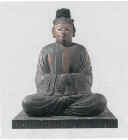The following piece by George A. Keyworth is extracted from the beginning of a longer paper, annotated and with Japanese kanji for names. To see the original, please click here.
On the ‘SHINTŌ’ STATUES OF MATSUO SHRINE

In 2004, the curatorial staff at Kyoto National Museum launched a special exhibition called, ‘The Sacred World of Shinto Art in Kyoto’. Chief among the objects on display was a ‘seated male deity’ from Matsuno’o. The statue is 99.6 cm high, was apparently carved from a single block of Hinoki cypress wood, and can be dated to the mid ninth-century according to the consensus reached by art historians. Details provided by the accompanying exhibit catalog describe the statue as a gohōjin, a protector of the Buddhist dharma. It is most likely an image of the male Ōyamakui no kami (alt. Ōyamagui), who was enshrined at Matsuo alongside his wife, Ichikishimahime no mikoto (alt. Okitsushima), no later than 866 CE. What makes this statue unique is its status as the oldest so-called ‘Shintō’ statue from Kyoto, as well as the fact that it is the primary—or larger—one in a triad of ‘Shintō’ statues on display in a building called the Shinzōkan. This building has been on site at Matsuo Taisha in western Kyoto since 1975, when a major renovation of the shrine precincts was completed. Both the Shinzōkan and three landscape gardens—the Jōko no niwa (Prehistoric Garden), Kyokusui no niwa (Meandering Stream Garden), and Hōrai no niwa (Penglai Garden)—designed by Shigemori Mirei (1896–1975) promote the legendary antiquity of Matsuo shrine as the chief clan shrine for the Hata family. There seems to be scholarly consensus that the Hata clan of wealthy immigrants arrived in Japan from Silla (Shiragi), Korea—probably in the Chikuzen region of Kyūshū first—by the second half of the fifth-century.
In a study published in 2011 of the ‘Shintō statues’ of Matsuo shrine that are on display within the Shinzōkan, Itō Shirō, an eminent art historian and current director of the Wakayama Prefectural Museum, agreed that the ‘seated male deity’ lent to Kyoto National Museum in 2004 is a statue of Ōyamakui. However, he postulated that it may have been commissioned by Enchin (814–891), the Tendai patriarch and fifth abbot of Enryakuji on Mount Hiei , before he departed for China in 853. On the contrary, perhaps it is simply a mishōtai (lit. revered true body) that was enshrined at Matsuo kami shrine-temple complex or multiplex— jingūji —during the ninth-century. This is following eighth-century precedents historical accounts that discuss offerings being made to statues at shrine-temple complexes in the provinces, such as at Iwasahiko jinganji (Obama city, Fukui prefecture during the Yōrō period (717–724)…
***************
For the rocks and roots of Matsuo Shrine, please see here.
